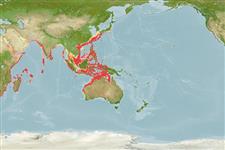>
Eupercaria/misc (Various families in series Eupercaria) >
Latilidae (Deepwater tilefishes)
Etymology: Branchiostegus: Greek, brangchia = gills + Greek, stego = roof, to cover (Ref. 45335).
Environment: milieu / climate zone / depth range / distribution range
Ecologia
marino demersale; distribuzione batimetrica 45 - 180 m (Ref. 9607). Deep-water
Indo-West Pacific: Red Sea and off Durban, South Africa. Reported from the Arafura Sea (Ref. 9819), northwestern Australia (Ref. 5978) and the Philippines (Ref. 9877, 9880).
Size / Peso / Age
Maturity: Lm ? range ? - ? cm
Max length : 60.0 cm TL maschio/sesso non determinato; (Ref. 5591)
Spine dorsali (totale) : 7; Raggi dorsali molli (totale) : 15; Spine anali: 2; Raggi anali molli: 12. Pinkish brown above, white below; caudal fin with 2 horizontal stripes; red spot on outer base of pectoral fins and black spot in axil (Ref. 5591).
Occurs in the continental shelf (Ref. 7300). Found over muddy bottoms (Ref. 5213). Considered poisonous by local fishers in the Red Sea and thus are generally discarded (Ref. 9880).
Life cycle and mating behavior
Maturities | Riproduzione | Spawnings | Egg(s) | Fecundities | Larve
Amirthalingam, C., 1969. A new fish from the Red Sea. Sudan Notes Rec. 50:129-133. (Ref. 9874)
IUCN Red List Status (Ref. 130435)
Threat to humans
Poisonous to eat (Ref. 9880)
Human uses
Strumenti
Special reports
Download XML
Fonti Internet
Estimates based on models
Preferred temperature (Ref.
123201): 20.5 - 27.8, mean 25.3 °C (based on 265 cells).
Phylogenetic diversity index (Ref.
82804): PD
50 = 0.5000 [Uniqueness, from 0.5 = low to 2.0 = high].
Bayesian length-weight: a=0.00708 (0.00294 - 0.01707), b=3.07 (2.86 - 3.28), in cm total length, based on LWR estimates for this (Sub)family-body shape (Ref.
93245).
Trophic level (Ref.
69278): 3.6 ±0.5 se; based on size and trophs of closest relatives
Resilienza (Ref.
120179): Medio, tempo minimo di raddoppiamento della popolazione 1.4 - 4.4 anni (Preliminary K or Fecundity.).
Fishing Vulnerability (Ref.
59153): Moderate vulnerability (44 of 100).
